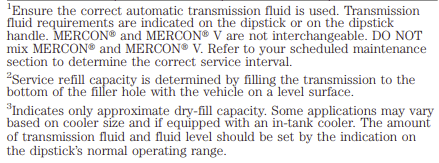The Mazda Tribute stands as a testament to Mazda’s foray into the compact SUV market. Launched at the turn of the millennium, the Tribute was Mazda’s response to the growing demand for sport utility vehicles that offered both the comforts of a passenger car and the versatility of an SUV.
Key Takeaways:
- Know Your Fluid: Understanding the type and capacity of transmission fluid for your Mazda Tribute’s specific generation is crucial. The fluid capacity is between 2.3 and 13.4 quarts (depending on the transmission type).
- The Right Time: Change the transmission fluid at recommended mileage intervals. Regular maintenance can significantly prolong the vehicle’s lifespan and maintain optimal performance.
- Signs of Trouble: Stay alert to signs that might indicate a need for a fluid change, such as difficulty in shifting gears, unusual noises, or slipping transmission. Addressing these early can save costly repairs down the road.
- Dealership vs. Independent Mechanic: While dealerships offer specialized services and genuine parts, independent mechanics can provide more competitive rates. Consider both options based on your budget and vehicle needs.
- Cost Factors: The type of fluid, labor rates, location, and additional services can influence the cost of changing the transmission fluid. Be aware of these factors when budgeting for maintenance.
- Regular Checks: Even between the recommended intervals, it’s a good idea to periodically check the transmission fluid level and its condition. If it’s too dark or has a burnt smell, it might be time for a change.
- Genuine Parts: If opting for services outside of a dealership, ensure that any replaced parts are of high quality, even if they are aftermarket. This ensures the vehicle’s reliability and safety.
- Transmission’s Role: Never underestimate the importance of the transmission in your Mazda Tribute. It’s vital for the car’s performance, fuel efficiency, and overall lifespan.
- Stay Informed: With vehicles, knowledge is power. Familiarize yourself with your Mazda Tribute’s maintenance needs and stay proactive in its care.
- Consistent Maintenance: Beyond the transmission, ensure your Mazda Tribute undergoes regular maintenance checks, including engine oil changes, brake inspections, and tire rotations. A holistic approach ensures the vehicle runs smoothly for years to come.

While its exterior boasted rugged SUV lines, its interior was designed to offer comfort, making it a perfect blend for those who sought the best of both worlds. Produced in collaboration with Ford, sharing a platform with the Ford Escape, the Tribute was both stylish and functional.
Throughout its production cycle, it underwent various facelifts and updates, ensuring it stayed relevant in an ever-evolving market.
Transmission fluid plays a paramount role in the overall operation and longevity of any vehicle, and the Mazda Tribute is no exception.
This fluid serves multiple purposes: it acts as a lubricant, preventing wear and tear on the transmission’s components; it cools the system, ensuring that temperatures stay within optimal ranges; and it transmits power from the engine to the drive shaft.
For a vehicle like the Mazda Tribute, which was often tasked with city drives, highway speeds, and occasional off-road adventures, the health of its transmission fluid could directly influence its performance and lifespan.
A well-maintained transmission can lead to smoother gear shifts, better fuel efficiency, and prolonged vehicle life.
Conversely, neglecting this critical component can result in decreased performance, costly repairs, or even complete transmission failure.
Thus, understanding the right transmission fluid type and the correct capacity becomes an essential aspect of Mazda Tribute maintenance.
Transmission 101: Why Fluid Matters
In every vehicle, the transmission stands as one of the most sophisticated and essential components. It’s responsible for ensuring that the right amount of power goes to your wheels to drive at a given speed. Imagine trying to pedal a bike on its toughest gear up a steep hill – it’s nearly impossible.
But if you shift into a lower gear, you can pedal much more easily. The transmission in your car or SUV does the same thing, constantly ensuring the vehicle is in the “right gear.”
At the heart of this intricate system is the transmission fluid. This fluid serves multiple purposes:
- Lubrication: Just like your engine requires oil to lubricate the various components and prevent wear and tear, your transmission requires fluid to keep its parts moving smoothly.
- Cooling: Transmissions can generate a lot of heat, especially when driving aggressively or towing heavy loads. The transmission fluid helps absorb this heat and dissipate it more effectively.
- Hydraulic Function: Modern automatic transmissions are incredibly complex, with many electronic and hydraulic components that need to function in harmony. The fluid provides the hydraulic force necessary to shift gears.
The Connection Between Fluid and the Tribute’s Performance
For the Mazda Tribute, which was designed as a compact SUV capable of both city drives and more adventurous terrains, a functioning transmission is pivotal. The SUV needed to be agile and responsive in city traffic, but also capable when the road got rough. The right transmission fluid ensured smoother gear shifts, no matter the driving conditions.
When the transmission fluid is neglected or the wrong type is used, the Tribute could experience various issues. These range from decreased acceleration to problems shifting gears, and in severe cases, a complete transmission breakdown.
Given the cost of transmission repairs or replacements, it’s a component that no Tribute owner would want to neglect.
Understanding the intricacies of the transmission and the role of its fluid provides Tribute owners with insights into maintaining their vehicle’s performance and ensuring a longer lifespan.
Recommended Fluid Types for the Mazda Tribute Across Generations
For Mazda Tribute owners, it’s essential to use the recommended transmission fluid to ensure optimal performance and longevity. Here’s a breakdown of the suggested fluids for each generation:
- 1st Gen (EP) 2001 – 2004: Most models from this era recommend Mercon ATF for automatic transmissions.
- 1st Gen (EP) Facelift 2005 – 2006: Again, Mercon ATF is typically the go-to for automatic versions.
- 2nd Gen (CD2) 2008 – 2011: By this generation, Mercon LV ATF remains the standard for automatic transmissions in the Mazda Tribute.
Always remember, when filling or changing your transmission fluid, using the correct type is paramount. Not only will it keep the transmission functioning smoothly, but it will also prevent potential damage, saving you from costly repairs down the line.
2001-2011 Mazda Tribute Transmission Fluid Capacity
Maintaining the right amount of transmission fluid in your Mazda Tribute is crucial for the vehicle’s performance. Overfilling can lead to leaks and inadequate lubrication, while underfilling can cause overheating and decreased transmission function.
Here’s a breakdown of the transmission fluid capacities for the Mazda Tribute across its generations:
1st Gen (2001-2004) Capacities
Ensure the correct automatic transmission fluid is used. Transmission fluid requirements are indicated on the dipstick or on the dipstick handle. MERCON and MERCON V are not interchangeable.
DO NOT mix MERCON and MERCON V. Refer to your scheduled maintenance section to determine the correct service interval.
| Gearbox | Fluid capacity | Fluid type |
|---|---|---|
| Manual transaxle (2WD) | 2.7L (2.85 quarts) | API service GL-4, SAE 75W-90 |
| Manual transaxle (4X4) | 2.2L (2.32 quarts) | API service GL-4, SAE 75W-90 |
| Automatic transaxle (and oil cooler) | 12.7L (13.4 quarts) | Mercon ATF |

- Automatic Transmission: Typically, when draining and refilling the automatic transmission (such as during a routine service), you may need around 5-6 quarts (4.7-5.7 liters). However, if you’re doing a complete overhaul or if the transmission is dry (like after a rebuild), it can take up to 13.4 quarts (12.7 liters).
- Manual Transmission: Manual versions during this generation usually have a capacity of around 2.8 quarts (2.7 liters).
1st Gen Facelift (2005-2006) Capacities
| Gearbox | Fluid capacity | Fluid type |
|---|---|---|
| Manual transaxle (2WD) | 2.3L (2.4 quarts) | API service GL-4, SAE 75W-90 |
| Manual transaxle (4X4) | 2.4L (2.5 quarts) | API service GL-4, SAE 75W-90 |
| Automatic transaxle | 9.6L (10.2 quarts) | Mercon ATF |
- Automatic Transmission: For a drain and refill, expect to use around 5.5-6.5 quarts (5.2-6.1 liters). For a completely dry system, it might be up to 10.2 quarts (9.6 liters).
- Manual Transmission: The capacity remains relatively consistent with the previous generation, holding about 2.5 quarts (2.4 liters).
2nd Gen (2008-2011) Capacities
| Gearbox | Fluid capacity | Fluid type |
|---|---|---|
| Manual transaxle | 2.4 quarts (2.3L) | API service GL-4, SAE 75W-90 |
| Automatic transaxle | 9.0 quarts (8.5L) | Mercon LV ATF |
- Automatic Transmission: A standard drain and refill will typically need between 5.8-6.8 quarts (5.5-6.4 liters). However, if you’re starting with a dry system, it can require up to 9 quarts (8.5 liters).
- Manual Transmission: By this generation, the manual transmission capacity might vary slightly based on specific models, but generally, it’s around 2.4 quarts (2.3 liters).
These are general guidelines based on the most common Mazda Tribute models. Always consult your owner’s manual or contact a Mazda dealership for the most accurate information for your specific vehicle.
When and Why to Replace Transmission Fluid
Transmission fluid is the lifeblood of your Mazda Tribute’s transmission system. Ensuring that it’s in the best possible condition and replaced at appropriate intervals can mean the difference between a smoothly operating vehicle and costly repairs.
Let’s dive into understanding when and why you should replace the transmission fluid in your Mazda Tribute.
Why Replace Transmission Fluid?
- Lubrication: Transmission fluid lubricates the moving parts inside your transmission. Over time, due to wear and contaminants, the fluid’s lubricating properties can degrade.
- Cooling: The fluid helps in dissipating the heat generated within the transmission. Old or burnt fluid might not cool the transmission effectively, leading to overheating.
- Pressure Transmission: Modern automatic transmissions operate using hydraulics. The fluid transmits the necessary pressure to change gears and operate the clutch.
- Protection: A fresh batch of transmission fluid can protect the metallic surfaces from wear, and detergents within the fluid can help keep the system clean.
Signs Indicating a Need for Fluid Change
- Color Change: New transmission fluid is typically a bright red. Over time, as it gets contaminated, it turns brown or even black. If your fluid is dark or has a burnt smell, it’s time for a change.
- Grinding or Strange Noises: If you hear unusual noises when your car is in neutral, it might indicate that your fluid levels are low or that the existing fluid is too old and thick.
- Delayed or Hard Shifting: If your Tribute hesitates when shifting or does so with a jolt, old or insufficient fluid might be the culprit.
- Transmission Slippage: If your vehicle changes gears without any input or has trouble staying in gear, it’s a clear indication that your transmission fluid needs attention.
- Warning Lights: Modern vehicles come equipped with sensors that can detect problems or low fluid levels. If your transmission or check engine light illuminates, get your vehicle checked.
Recommended Mileage Intervals for the Tribute
For optimal performance:
- Automatic Transmission: It’s generally recommended to replace the fluid every 30,000 miles. However, if you use your Tribute under severe conditions like frequent stop-and-go driving, towing, or driving in extremely hot/cold climates, you might want to change it every 20,000 miles.
- Manual Transmission: Manual transmissions don’t generate as much heat and often have longer intervals. You can typically replace the fluid every 100,000 miles.
Cost Implications: Dealership vs. Independent Mechanic
Maintaining the transmission fluid of your Mazda Tribute is crucial for its longevity and efficient performance. But where should you get it serviced?
While dealerships offer specialized knowledge and genuine parts, independent mechanics can provide competitive rates.
Here’s a breakdown of the costs and factors to consider:
Average Cost Ranges
- Dealership: Typically, having your transmission fluid changed at a dealership is more expensive. You might be looking at a range of $150 to $250 for the service. The exact amount can vary based on your location and the specific dealership.
- Independent Mechanic: An independent mechanic, due to lower overhead costs and the ability to source third-party parts, might charge you anywhere from $100 to $180 for the same service. However, the range can vary based on the mechanic’s reputation, expertise, and location.
Factors That Influence Cost
- Type of Transmission Fluid: Not all transmission fluids are created equal. Synthetic fluids, which offer better performance and longevity, tend to be more expensive than conventional ones.
- Labor Rates: The hourly rate can vary significantly between a dealership and an independent mechanic. Dealerships tend to have higher hourly rates due to the specialized nature of their services.
- Additional Services: Sometimes, during a fluid change, other issues might be discovered, such as leaks or parts that need replacement. Such additional services can increase the final bill.
- Location: If you’re in a metropolitan area, both dealerships and independent mechanics might charge more due to higher operational costs.
- Genuine vs. Aftermarket Parts: Dealerships use genuine parts, which can be more expensive. Independent mechanics have the flexibility to use aftermarket parts, which might be cheaper but equally effective.
- Expertise and Specialization: A mechanic specialized in Mazda vehicles might charge a premium for their expert services compared to a general mechanic.
















